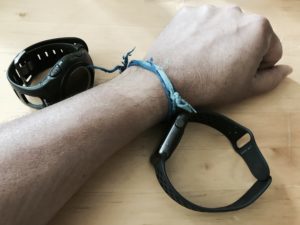 About two months ago I retired my Suunto T6 (left in image) and got an Apple Watch (right in image). The Suunto was top of the line wrist-top computer for 2006. Like other running watches, I used it to track heart rate (with belt), time runs and intervals, and measure speed (with foot pod). And like other sports watches, it was quite well-suited for what it was intended to do. This was indeed a smartwatch circa 2006.
About two months ago I retired my Suunto T6 (left in image) and got an Apple Watch (right in image). The Suunto was top of the line wrist-top computer for 2006. Like other running watches, I used it to track heart rate (with belt), time runs and intervals, and measure speed (with foot pod). And like other sports watches, it was quite well-suited for what it was intended to do. This was indeed a smartwatch circa 2006.
One thing I knew, during all these 11 years I had the watch, was that it had a prized position on my wrist. And anything that wanted to displace it was fighting for that position.
Quick saturation of wrists
Most seem to talk about smartwatches as something that has infinite growth potential. In reality, smartwatches will likely be limited to one wrist per person (duh). Therefore, the activation energy to get one includes convincing someone that a new watch is enough to displace an old watch.
Now that I have an Apple Watch, it is highly unlikely that I will replace it with something for many years to come. The watch is stuck on my wrist.
And once I have the watch on, why would I also get a fitness band to jostle on my wrist? Because activity tracking is just another feature of the Apple Watch, once an Apple Watch gets on a wrist, whole swaths of fitness wearables become irrelevant.
Variety is the spice of wearables?
This occupation of the wrist also means other watches are excluded. Swatch historically has tried to counter this exclusion by making customizable watches and bringing the prices down so that it is easy to have multiple watches.
Also, in the mechanical watch world, it’s easy to have a day watch, a night watch, a swim watch, since things are simple, you won’t lose data, and the watch is basically like jewelry. But we haven’t hit that range or functionality with smartwatches to encourage owning multiple.
Smartwatch manufacturers will have the pride of place. And woe to any wearable manufacturer competing for that same wrist spot.
Running with jewelry
But it’s not that dire. Those who make wearables that do not go on the wrist, say rings or clips or pendants, have a better chance to compete for users without the problems of being excluded. Though they should approach their position as jewelry that is used briefly, swapped out with other jewelry, and needs to be designed well (especially user value).
Just stay off the wrist. 🙂
What do you think?